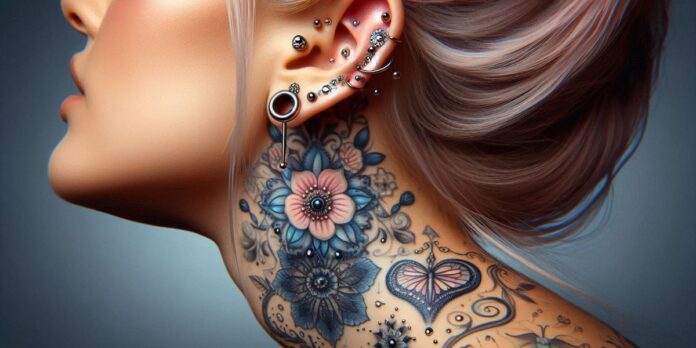Though it’s an amazing experience, a piercing also carries a lot of responsibilities. Making sure your new piercing heals correctly will help you prevent problems, including scars and infections. One must keep things right. Knowing your piercing’s anatomy and healing process will help you care for it.
Selecting the correct piercing specialist
Making sure suitable healing results starts with selecting a certified piercing specialist. A professional piercer uses sterile tools and techniques; her main concerns are hygiene and safety. Select the best piercing shop that maintains stringent hygienic standards top priority in your research.
A competent piercer’s advice on maintenance could significantly influence the healing process. By visiting the most renowned piercing clinic, you not only ensure a high-quality piercing but also gain valuable knowledge on maintenance and care.
Knowing how long healing takes
Each piercing heals differently based on location and health. Cartilage piercings heal slower than lobes. Knowing these schedules may help you stay calm throughout repairs and manage expectations. Aftercare should be consistent to maximize healing.
Preserve neat surroundings
Maintaining a clean environment is essential for piercing healing. Cleanliness reduces the risk of infection; therefore, it complicates the healing process. Before touching your piercing, give your hands a thorough wash-through.
This easy but efficient process helps stop the spread of possibly disease-causing bacteria. In addition, it’s important to maintain proper hygiene in your mattress and clothing to safeguard your piercing from irritation and contaminants.
Appropriate Cleaning Methods
Proper cleaning of the piercing is essential for it to heal faster. As suggested by your piercer, clean with a gentle, non-alcoholic solution or saline one. Avoid alcohol and hydrogen peroxide because they are excessively strong and could damage the skin around the piercing.
Apply the solution gradually such that it reaches the piercing and removes trash and germs without aggravating it. Routine cleaning should occur twice a day, but avoid excessive cleaning as it could aggravate skin conditions.
Maintaining control over trauma and anger
To ensure a smooth healing process, keep your piercing free from trauma and discomfort. Use caution while acting in ways that can cause your jewelry to catch on clothes or other things. Physically demanding sports and activities could cause mishaps.
We advise engaging in such events under a protective covering to prevent trauma. Moreover, refrain from resting on the piercing’s side until it has fully healed. This will help to prevent discomfort and possibly local injury.
Look for signs of an infection
You must constantly monitor any changes to your piercing. An infection could manifest as excessive redness, discharge, edema, or pain. Should you have any of these symptoms, act immediately. You should gently wash the affected area and change your jewelry only once the infection has cleared. Sometimes it may be important to seek professional medical help. Early intervention typically prevents the emergence of a more serious issue.
Maintaining the jewelry’s status
The position of the jewelry determines the healing process. Make sure the jewelry on your piercing is firmly fastened and has adequate space to allow swelling without being too free-moving.
Unsuitably sized jewelry may cause discomfort and delay the healing process. If you experience irritation, consult your piercer about any necessary corrections. Before switching to decorative jewelry, kindly wait until your piercing has completely healed to avoid any possible problems.
The Part Hydration and Food Play in the Healing Process
Your general health significantly influences the healing of your piercings. Eating a balanced diet and keeping enough liquids will enable your body to recuperate faster. Eat plenty of foods heavy in vitamins and minerals and sip lots of water.
Vitamins A, C, and E should be the top priority for maintaining skin health. Meals high in zinc also might hasten the healing process by reducing inflammation and supporting tissue repair.
Patience is a necessary virtue
Healing takes time; every person’s body reacts differently. While your body grows adjusted to the new piercing, be patient with yourself as well. Steer clear of the temptation to replace your jewelry too quickly or to ignore your maintenance calendar. Sustaining healing requires consistency. Little setbacks can occur, so keep your attitude toward your treatment proactive to guarantee the best outcome.
Attaching Professional Support
Please don’t hesitate to seek expert help if your piercing causes you ongoing difficulties. Your piercer can offer perceptive guidance and decide whether more intervention is required. In more dire circumstances, it could be imperative to consult a healthcare provider. Being proactive and informed about your piercing maintenance will help you avoid long-term problems and have a better general experience with it.
Embracing Your Piercing Journey
To conclude, good piercing care promotes recovery and boosts confidence. Understanding hygiene, care, and infection prevention will help you manage piercings. Your piercing should heal properly and let you wear your original style with patience.
Finally, setting up your piercings for healing is smart body art. Choosing a reliable practitioner, cleaning your piercing, and monitoring its growth will help you heal. You can show off your piercing for years thanks to good aftercare.
